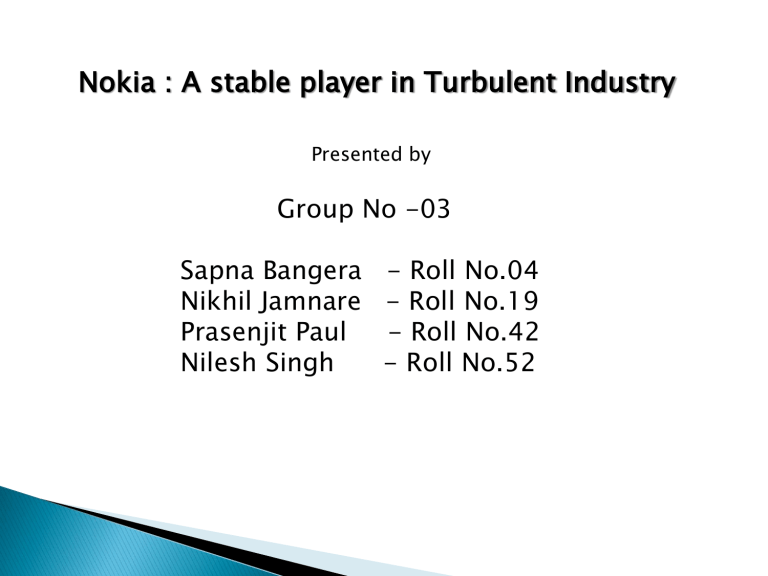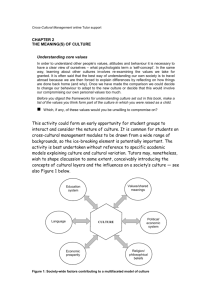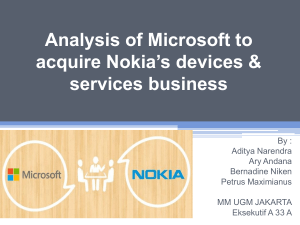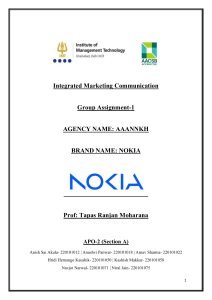SM PPT_Group No.3

Nokia : A stable player in Turbulent Industry
Presented by
Group No -03
Sapna Bangera - Roll No.04
Nikhil Jamnare - Roll No.19
Prasenjit Paul - Roll No.42
Nilesh Singh - Roll No.52
2007- Global market volume of mobile phone- 1.15 billion units
(16% increase from 2006)
3 billion users word wide
Prediction to reach $ 200 billion by 2011
Mobile phone industry grew- 50% growth from 1996 to 2000
Nokia- Finland based company -1990 as core business
Nokia became market leader in 1998
Nokia was ranked no.5 in 2007 in telecommunication by
Interbrand a leading brand consultancy
Nokia sold 437 Million handsets in 2007 – an increase of 26% from
2006
Made net profit $10.5 billion on the net sale of 74.6 billion – 2007
Operated in more than 150 countries.
Joint venture with AT&T in US and with GSM in Asia and Europe
Market Strategy- Large Market Share and Economy of Scale
Came with cheap handset to attract immerging market- But faced problem in US and Europe
Introduced first smart phone Nokia 9000 in 1996
Nokia opened Concept Store which gave redefined retail experience.
In-house manufacturing- Vertically integrated.
In 2007- outsourcing around 20% of total volume.
Introduced Multisourcing model- different suppliers for different product level.
Nokia ranked 2 nd in 2008 for supply chain efficiency by AMR
10 manufacturing facility in 9 countries
Manufacturing facility in India- Chennai Plant which exported to
58 countries and became companies global operation centre
In 2007- Almost half of the 185 million handsets sold in India were from Nokia.
In 2006- For US market Nokia Introduced clamshell style phone
6555 exclusively for AT&T.
Nokia integrated various internet service under one brand OVI.
In 2007- restructuring business divisions- Mobile phone, multimedia, enterprise solution and Nokia Siemens division into two divisions- Mobile and Internet technology.
Launch of Fairphone, an ethically sourced and produced mobile phone, put a spotlight on the raw materials in our digital devices. The Dutch company, currently taking orders for a second batch of 35,000 phones, ensures that minerals come from conflict-free areas so they’re not helping to fund armed groups. And Intel is showcasing its commitment to using conflict-free minerals in its microprocessors, in a two-minute spot and on its website. CEO Brian Krzanich also spoke on the topic at
2014’s Consumer Electronics Show.
Why it’s interesting:
Expect more tech companies to start improving their track record on how their products are made.
Disruption in the payments sphere is opening the way for social media brands to act as intermediaries between consumers and their money.
Facebook is said to be planning a P2P payments feature for Messenger, South Korea’s KakaoTalk announced a
PayPal-like service, and Line is creating a mobile service that will let users make online and offline purchases.
Snapchat is partnering with Square to enable payments between users, as explained in an energetic retro musical number delivered by video. After users (U.S. and 18-plus only) enter bank card information, they simply send a cash amount within a text.
Xiaomi, which we is included in the 100 Things to Watch in
2014 list, is now the world’s third-largest smartphone maker. The young company has seen triple-digit yearover-year growth in smartphone shipments surging ahead of both LG and Lenovo.
Often described as the “Apple of China,” Xiaomi released its first phone just three years ago; its latest, Mi4, is an iPhone clone that runs on a modified version of Android.
The company is expanding beyond China into India and
Singapore, and planning to enter a slew of other growth markets, including Russia, Turkey, Brazil and Mexico.
It’s also getting into the content game and smart-home products.
Why it’s interesting:
◦ From luxury to technology, BRIC and emerging-market brands are increasingly hitting the global stage.
The startup Circle launched a web app that effectively functions as a bitcoin Bank.
Using a Debit card or a bank account, users transfer funds to Circle, which converts money to bitcoin at no fee.
Circle also insures this money at no cost
The company aims to make bitcoin more accessible via consumer friendly design and is aiming to take on traditional banks and companies like Pay Pal.
Advances in Smartphone cameras and the proliferation of mobile editing and recording apps are turning the mobile device into a portable studio capable of professional standard results
.
Why it’s interesting:
More than ever, the latest smartphones are allowing consumers to become content creators, and generators of entertainment and highquality visual media. And with their increased technical capabilities, they are taking over from traditional products such as SLR cameras
Walmart’s mobile app uses location as context for flipping into “store mode.”
Do you understand customer context well enough to help serve customers in their mobile moments? Are you engaging customers in the right moment to drive the next purchase or brand engagement?
Traditional marketing and customer feedback only tells part of the story. Are you tapping into customer mobile data to understand what they really think?
Are you collecting data from products to layer on services? Or give customers more control?
Are you using customer purchase data to improve conversion rates in-store and online?
Combine real-time analytics with push notifications to help deliver contextualized experiences.
Use data to understand when consumers are in their exact moment of need and to meet that need with the right message or service.
New mobile-centric ad formats will emerge.
More mobile ad network will shift to the exchanges.
Short videos (5 to 10 seconds) will make a greater impact on consumers, taking advantage of higher engagement levels with video on mobile. Shift the way you think about mobile advertising
Integrate mobile into your marketing strategy by taking advantage of mobile’s unique benefits.
Test new ad formats and compare their ability to meet your marketing goals.
Total product concept of Nokia and Mobile handset industry
CREDIT/
PAYMENT
TERMS
BRAND
QUALITY
LEVEL
AUGMENTED:
ACTUAL:
CORE:
BASIC
NEED,BENEFIT
PACKAGING
FEATURES
DELIVERY
DESIGN
First Mover advantage
Technological leadership- (R&D)
Control of resources
Scale effect
Switching costs and buyer choice under uncertainty
Network externalities
Second-mover advantages
Free-rider effects
Resolution of technological or market uncertainty
Shifts in technology or customer needs
Government interference
Brands stop being the major driving force in consumer decision and low price becomes paramount. Due to this, differentiation has become a challenge for manufacturers.
Google’s strategy of providing open source Android platform free to mobile manufacturers has played a key role in the commoditization process.
Mobile manufacturers could therefore concentrate on hardware manufacturing and marketing.
Buyers from emerging markets like China and India are more price conscious than their Western counterparts since handsets are not subsidized by carriers in these markets.
Smartphone's are not only getting cheaper but they are getting better with each launch.
Established players like Apple and Samsung would have to innovate in order to keep the exclusivity of their phones in the face of such competition.
Looking ahead, it is vital for manufacturers to not only keep their costs in check and remain innovative, but also react quickly to the changes in the industry.
More importance of technology( Software) than hardware as decision making factor. Example- Apple
Value Chain Trends
Increased urbanization
Aging population
Increased spread of wealth
Increased impact of consumer technology adoption
Increase in consumer service demand
Increased importance of health and wealth being
Growing consumer concern about sustainability
Shifting of economic power
Scarcity of natural resources
Increase in regulatory pressure
Rapid adoption of supply chain technology capabilities
Impact of next generation information technology
Research and Development
Product Design
Production Process
Marketing and Sales
Distribution Management
Customer Service
• What is the best end-to-end value chain that meets business objectives of lowest total costs, utilization and customer service levels?
• What is the best sourcing, manufacturing and distribution strategy?
• What supply and capacity policies should be in place to ensure the required flexibility?
• What should be the inventory policy and positions at different nodes in the value chain?
• What is the carbon footprint of our existing or potential value chains?
• What if some of the underlying assumptions are modified - test of robustness?
Strength
Brand Awareness
Technology leader in manufacturing mobiles
Market leader
Presence across 150 countries
Opportunity
Huge loyal customer base
Huge presence in developing countries
Can use its infrastructure business(Nokia
Siemens Network) to reduce the bargaining power of mobile
Weakness
Not good at software
Performance of symbion OS is lackluster
Increasing dissatisfaction level with its
Smartphone
Very weak market share in Smartphone
Threats
Rapidly changing industry
Chances of missing inflection point is high
Threat of entry of new players like
Microsoft, Google has just entered
Learnings
• Segmentation----Expand total market -
Tapping new customers and increase frequency of use
• Acquisition and merger etc
• Defensive market share -Continuous innovation along with customer services and distribution effectiveness , customer service,
Product differentiation
• Economy of scale- Expanding market share
• Value chain management
• Technology advantage- R&D
Thank you
.



